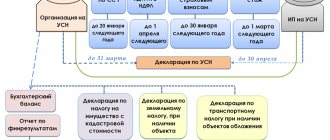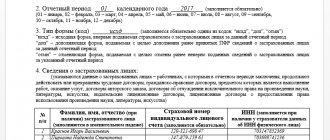Every year all Russian organizations and enterprises... no, they don’t go to the bathhouse, but submit their financial statements. This is not one or two reports, but several voluminous forms and explanations in which you need to detail the history of economic activity for the year. The completeness of the report depends on the form of ownership, status and size of the legal entity. We will help you figure out who needs to submit what and to whom.
Accounting reports, unlike tax reports, are submitted only once a year to the authorities of Rosstat and the Federal Tax Service. Although for your founders and shareholders it can be filled out much more often: once a quarter or, for example, monthly. The purpose of these reports is clear from the name: they show a complete picture of the economic and financial situation of the organization over time. The current forms of financial statements were approved by Order of the Ministry of Finance of Russia dated July 2, 2010 No. 66n. The most famous of them are the balance sheet and income statement, or, as many accountants call it in the old-fashioned way, the “income statement.” The Federal Law of December 6, 2011 No. 402-FZ “On Accounting” regulates the procedure for submission and composition of documents.
What and when to take
| № | What is included in financial statements 2020 | What approved the current form for 2021 | Deadline for submission to the Federal Tax Service |
| Basic forms | |||
| 1 | Balance sheet (so-called form No. 1) | Appendix No. 1 to the order of the Ministry of Finance of Russia dated July 2, 2010 No. 66n (as amended on April 19, 2019) “On the forms of financial statements of organizations” | Last day – 03/31/2020 (Tuesday) Transferred to 05/06/2020 |
| 2 | Statement of financial results (so-called form No. 2) | ||
| Applications | |||
| 3 | Cash flow statement | Appendix No. 2 to the order of the Ministry of Finance of Russia dated July 2, 2010 No. 66n (as amended on April 19, 2019) | Last day – 03/31/2020 (Tuesday) Transferred to 05/06/2020 |
| 4 | Statement of changes in equity | ||
| 5 | Report on the intended use of funds | Appendix No. 2.1 to the order of the Ministry of Finance of Russia dated July 2, 2010 No. 66n (as amended on April 19, 2019) | |
| 6 | Explanations | Free form, but in order No. 66 there is an example of a standard one in the new edition | |
The composition of accounting reports in 2021 is regulated by Part 1 of Art. 14 of the Law on Accounting No. 402-FZ.
How to simplify the submission of JSC reports
Electronic submission of reports of OJSC and CJSC remains relevant even after the transition to the forms of public and non-public joint stock companies.
Special software helps to simplify the preparation of necessary documents and avoid fines from government agencies - for example, VLSI Electronic Reporting. This is a universal reporting tool that fills out legally required forms with minimal user interaction. VLSI monitors the tax calendar and promptly notifies you of upcoming dates.
With this program, electronic reporting of OJSC and CJSC is generated in a minute, and also undergoes automatic verification and is sent to the regulatory authorities of your choice via the Internet - at any time convenient for you.
Rate this article:
Major changes from 2021
Numerical indicators in accounting reports are allowed to be given only in thousands of rubles, but not .
There's a bang in the hat. the balance sheet now needs to indicate whether the statements are subject to mandatory audit. And if yes, then information about the auditor.
The machine-readable reporting form KND 0710099 has been significantly adjusted to take into account changes in PBU 18/02, which regulates income tax calculations. They begin to operate in 2021. But it is not necessary to report on the new form for 2021. It is mandatory only for those who, starting from 2021, voluntarily apply the new version of PBU 18/02.
For more information about this, see “How to apply the new rules of PBU 18/02 from 2021.”
The machine-readable formats and forms for presenting accounting reports recommended by the Federal Tax Service of Russia are given in letter No. VD-4-1/24013 dated November 25, 2019.
In addition, the obligation to submit a copy of the accounting records to Rosstat has been canceled.
Also see “What is GIR BO of the Federal Tax Service of Russia as an official accounting resource.”
Starting with the 2021 report, all organizations, except representatives of small businesses, submit reports only in electronic form.
Starting from reporting for 2021, the head of the company has the right to sign an electronic balance sheet using an electronic digital signature (updated version of Part 8 of Article 13 of the Accounting Law).
Read also
15.11.2019
Linking accounting reporting forms for 2021
At this point you need to remember the basic principles and methods of accounting. It is well known that accounting must reliably reflect complete information about the obligations, state of property and capital of the organization and all changes that occur in them. Such control is carried out through a complete, continuous and documentary reflection of all business transactions in the organization on the basis of double entry. This means that each digit in the accounting data is posted to two different accounts, debit and credit. Thanks to this, a balance is achieved when the debit part is always equal to the credit part, if no errors were made. This method naturally concerns accounting results, so all forms of annual financial statements for 2021 are comparable and must be linked to each other. This is, first of all, checked by regulatory authorities when they receive documents from legal entities.
Creation of analytical OSV according to NAS
In order to create an analytical SALV (AOSV) according to NAS, on the basis of which transformation will be carried out in the future and reporting will be prepared, the data of the synthetic SALV according to NAS must be transferred to a copy of the report created for the AOSV according to NAS. To do this, in the form of a report, on the basis of which a copy of the analytical SALT report according to NAS is prepared, links to synthetic SALT according to NAS are written in the indicator cells. For example, to transfer indicators for account 59 “Provisions for impairment of financial investments” from the synthetic SALT to the analytical one, the following links are written:
- SND59
and
SNK59
for the initial debit and credit balances; - DO59
and
KO59
for debit and credit turnovers; - SKD59
and
SKK59
for the final debit and credit balances.
Such indicators cannot be deciphered by analysts, since their source is synthetic SALT. If the indicator requires decoding by analysts, then the link is written not to the synthetic OSV according to the NAS, but to the FSD, which contains such analytics and is stored in the system in the form of a copy of the report created at the previous stage (Fig. 5).
Rice. 5. Link to data sources in the AOSV according to NAS
For example, to decipher indicators for account 62.01 “Settlements with buyers and customers,” formulas are written containing:
- links containing the name of the report type, which stores analytical data on the indicator downloaded from the FSD (Figure 5 shows a link to FSD 07 PCK_Debt
, where a breakdown of receivables by counterparties and contracts is stored); - cells of the report type from which you want to take the indicator;
- analytics by which the indicator is deciphered.
Thanks to the specified links and formulas, a copy of the AOSV report according to NAS is filled out automatically. After filling out, it is necessary to check that all AOSV indicators according to NAS correspond to the synthetic AOSV according to NAS. If this condition is not met, it means that either the transcripts in the FSD do not correspond to the original OCB indicator, or the links are configured incorrectly.
To automatically perform the verification procedure, you can create a separate type of report in which you can configure verification formulas. Error Log button becomes available.
, which generates an error report to help determine the cause of the discrepancies. Only if the indicators of synthetic and analytical TSA according to NAS are completely identical can we proceed to the next stage.
Why track adjustments to reporting forms?
According to paragraph 7 of Art. 80 of the Tax Code of the Russian Federation, report forms and the procedure for submitting them are approved by the tax inspectorate together with the Ministry of Finance. At the same time, in paragraph 2 of Art. 4 tbsp. 80 of the Tax Code of the Russian Federation states that the Federal Tax Service does not have the right to refuse to accept a report from a business entity, but only if it is drawn up in the format established by law.
Accordingly, if a taxpayer uses an unspecified reporting form, incl. and outdated, tax authorities have the right not to accept the document. Due to non-acceptance of the report, the Federal Tax Service may apply penalties and even block the taxpayer’s current accounts.
Differences between the transformational and transactional models in individual accounting blocks
Both accounting models provide the ability to perform automated transformation adjustments as a result of parallel accounting of individual transactions. For both models, a period-closing mechanism is provided, independent of NAS. At the same time, the technology for maintaining parallel accounting and closing a period differs in the transformational and transactional accounting models.
Parallel accounting in the transformational and transactional models differs in the way data is entered. In the transformation model, initially all business transactions are transferred to IFRS. Then, at the time of parallel accounting documents, those transactions for which parallel accounting is provided are reversed.
In the transactional model, transactions for which parallel accounting is provided in IFRS are not translated (they are excluded by setting selections and filters during translation). Thus, at the time of posting parallel accounting documents, the corresponding transactions do not need to be reversed.
In addition, in the transformational and transactional models, the methods of filling out parallel accounting documents with initial information differ. In the transformation model, the source information is Excel data collection forms - it is from these forms that the source information for parallel accounting documents is imported. In the transactional model, source information for parallel accounting documents can be imported from the accounting system and subsequently adjusted by the user.
A feature of period closure in the transformational accounting model is the need to launch a regulatory operation to repeat adjustments from previous periods in each reporting period. This operation transfers manual and automatic adjustments made in prior period report instances to the current period.
In the following articles devoted to IFRS accounting in 1C: Holding Management 8, we will talk in detail about individual accounting objects (VNA, reserves, etc.), about the features of the formation of transformation adjustments within each accounting block, including the repetition algorithm adjustments of previous periods, as well as the period-closing procedure.
Accounting according to IFRS and making transformation adjustments
To further transform the source data according to NAS into IFRS indicators, transformation adjustments are applied to the analytical IFRS according to IFRS obtained as a result of the translation. Transformation adjustments can be made manually (using the reference book Templates for transformation adjustments
), and automatically as a result of parallel accounting documents in the IFRS subsystem (reserves, VNA, etc.).
A feature of using the transformation model when preparing adjustments under IFRS is that the translated data from NAS, for which the assessment in IFRS differs, is reversed, and for IFRS purposes, their own amounts are calculated within each accounting block. This is due to the fact that in the transformation model, the entire OSV is translated according to the NAS, that is, all the source data from the NAS. To reverse NAS data in documents of the IFRS subsystem, information about the accounts of these objects is required after translation with IFRS analysts. IFRS accounts in documents are filled in automatically according to the translation rules specified in the translation template settings.
For example, in the transformation model it is necessary to reverse expenses for the depreciation accrued for the period on fixed assets (FPE), reflected in NAS on account 26 “General expenses”. Postings must be made on the IFRS chart of accounts, therefore, instead of account 26, account 6.3.00.26.02 “Administrative expenses” of the IFRS chart of accounts will be substituted. This account is determined automatically from the broadcast rules based on the directory Basic broadcast templates
.
Automated transformation adjustments in the transformation model are the result of parallel accounting documents. Source information for parallel accounting documents can be imported from the corresponding FSD from Excel or entered manually. The program provides the possibility of parallel accounting of non-current assets (CNA), financial instruments, deferred taxes, as well as the possibility of double closing of the period. Within these sections, the following automated adjustments are possible in the transformation model:
- recalculation of costs taking into account cost adjustments in IFRS;
- revaluation of foreign currency assets and liabilities;
- recalculation of deferred taxes according to IFRS rules;
- calculation of depreciation, impairment, revaluations of fixed assets (fixed assets), adjustment of the financial result from the disposal of fixed assets;
- regulatory operation on financial instruments;
- revaluation of financial instruments at fair value, automatic calculation of provisions for doubtful debts based on parameters specified by users, calculation of the amount of discount and amortization of discount on financial instruments, automated recalculation of leasing obligations;
- calculation of financial results taking into account all manual and automated amendments to IFRS and balance sheet reformation.
Based on the results of adjustments to the initial NAS data, the analytical OSV under IFRS contains ready-made data for generating a package of reporting under IFRS. In AOSV according to IFRS, you can decipher the indicators for analysts in the form in which they were deciphered in the FSD or formed as a result of adjustments. To decipher an indicator, you need to select it with the cursor, activate the context menu with the right mouse button and select the Display disclosure
(Fig. 9).
Rice. 9. Explanation of AOSV IFRS indicators
In addition to the standard analytics that decipher the indicator, the analytics Types of movements
, if decoding was carried out on it in the FSD, or transformation adjustments were made. These analytics will allow you to generate the necessary notes in IFRS reporting.
Organization of reporting work
This method is much less common.
The right to sign is often held by the company's accountant. But if necessary, it can be transferred to any other authorized employee.
Registration of a power of attorney
The power of attorney to perform this procedure must be in writing. It should contain the following information:
- Passport details of authorized persons and a copy of an identity document.
- Date of document execution.
- Name of the organization and its legal address.
- Duration of the power of attorney.
Additional information about the financial statements of the enterprise in this video:
Its profitability largely depends on the document flow of an enterprise. And financial documents are simply an integral part of foreign economic activity. It is in reports and other papers that you can track the dynamics of development and the effectiveness of the current plan.
You can find additional information on the topic in the Documents for customs clearance section.
Free consultation by phone:
+7 (call is free)
Attention! Due to recent changes in legislation, the legal information in this article may be out of date!
Our specialist will advise you free of charge.
Types of organization reporting.
The adjusted data must be displayed in an explanatory note attached to the general financial statements and must contain a list of explanatory reasons why the original data was amended.
If the financial statements are approved, it is possible to change some of the data in which distortions and omissions were found. In this case, an offset is required between liabilities and assets of the balance sheet, as well as between profit and loss items.
Municipal (state) organizations must provide financial statements to those bodies that have the authority to manage state property. Budgetary organizations are required to provide all types of reporting: monthly, quarterly and annual. The deadline for provision is indicated by the authorized body.
All other organizations are required to provide financial statements to the specified addresses in one copy and, as a rule, free of charge. Quarterly reporting of organizations must be provided within 30 calendar days after the end of the quarter. Annual reporting requires submission within a longer period - 90 days from the end of the year.
The reporting year for the provision of financial statements of all organizations is considered to be the period from January 1 to December 31. For newly created enterprises, the reporting year is counted from the date of registration of the organization to December 31.








